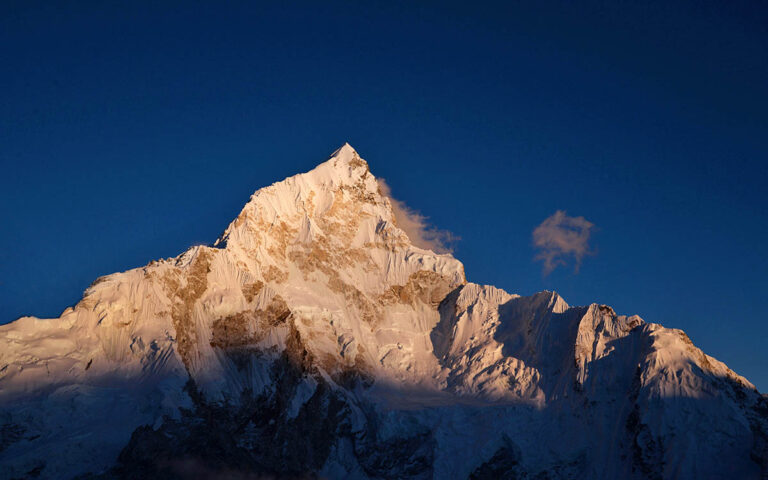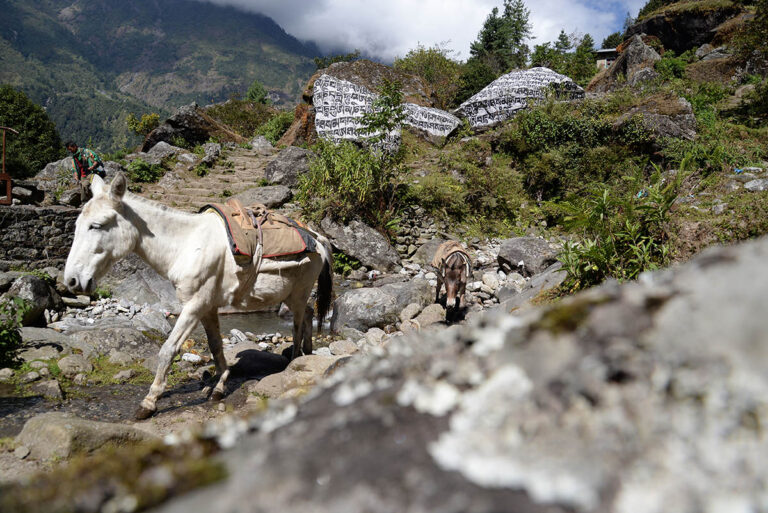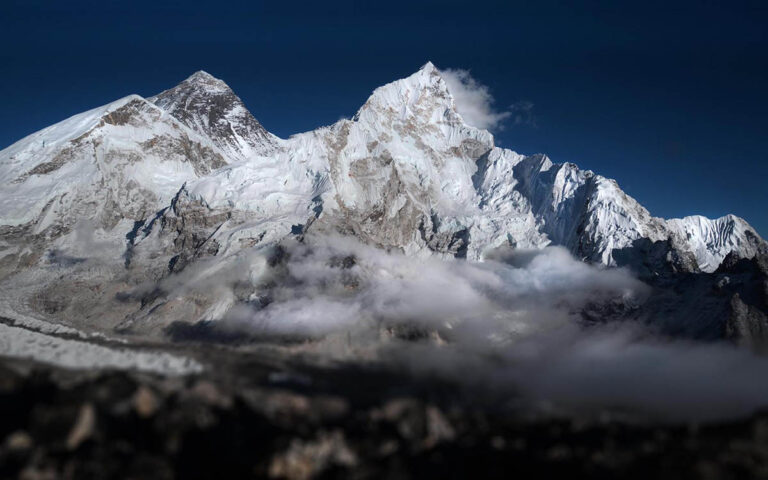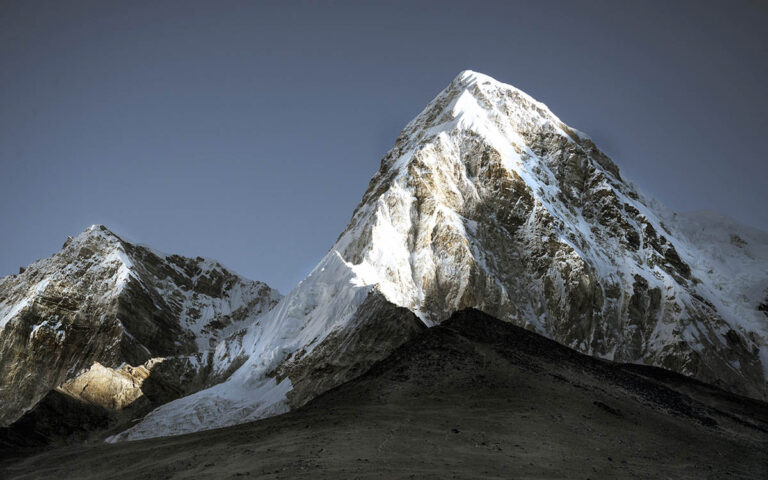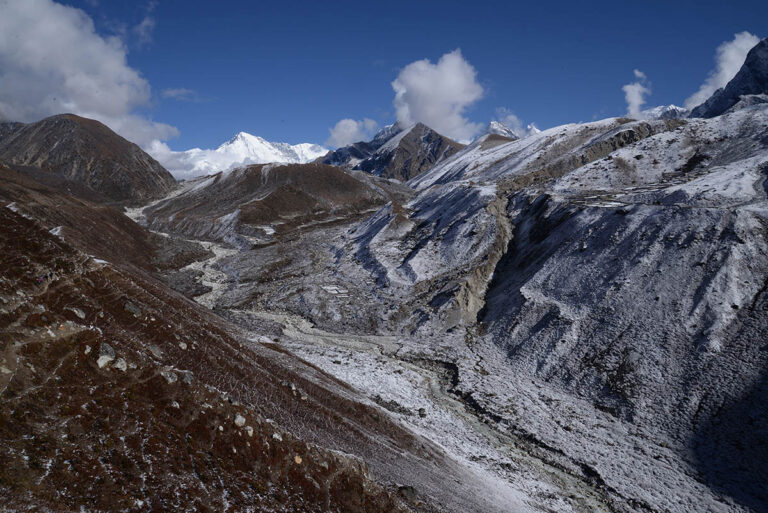Day 01 – Pick you up from the Tribhuwan International Airport in Kathmandu and transfer to the hotel. Your hotel will be located center of the Thamel; which is one of the touristic hubs of the Kathmandu city.
Day 02 – Sightseeing trip to the historical and ancient places around Kathmandu valley like the Pashupatinath Hindu temple, the Baudhanath stupa, Patan Durbar Square and the Swayambhunath stupa; which is also known as monkey temple due to moving hundreds of monkeys around the temple. After exploration of these places you will return back to hotel and your guide will brief you about the trekking trail, trekking gears and over the related topics.
Day 03 – Fly to Lukla and trek up to Phakding village (2610m.a.s.l) – 4 hours walk – we will fly about 30 minutes to get Lukla airport and trek continuously to Phakding village pass by many Sherpa villages with the view of Kongde, Nupla and Kusum kangaroo peak. Trekking from Lukla to Phakding would be a very joyful walk due to the flat trail that offers to see wonderful “Mani walls”, spinning prayer wheels and prayer flag; which are hanging along the trail.
Day 04 – Trek to Namche bazaar (3440m.a.s.l) – 6 hours walk – The trail leads just along the bank of the Dudhkoshi River and passes through the Sherpa settlements called Toktok, Benkar, Monjo and Jorsalle village. From here we will enjoy with the view of Thamserku peak, green hills and some beautiful waterfalls. From the Jorsalle village we will walk on the flat trail about 30 minutes to get Larja Dobhan where can be seen two awesome hanging bridges over the confluence two Rivers. Then we will climb up about two hours to get Namche bazaar through the pine and the colored Rhododendron forest.
Day 05 – Acclimatization day – Normally trekkers spend two nights in Namche Bazaar for the acclimatization and the sight walks. There are many sight trips around the Namche bazaar, among of them; sight trip to the Everest view point is being very popular due to the good view of landscapes, deep gorge of Dudhkoshi River valley, dozens of snow-capped peaks known as Taboche, Thamserku, Cholatshe, Amadablam, Iceland peak, Nuptse, Lhotse and including mount Everest. The Everest viewpoint is located just north side of the Namche bazaar and can be reached after one and half hours climb from the guesthouse of Namche bazaar.
Day 06 – Trek to Tengboche (3860m.a.s.l) – 6 hours walk – we will climb up about 15 minutes to get top of the Namche Bazaar then we will walk an approximately two hours on the flat trail to get Kyanjuma village with the view of Amadablam, Taboche, Thamserku and the deep valley of Fungitanga. Kyanjuma village is a trail junction for Gokyo valley and Everest base camp so we will turn to the right-hand side and trek down an approximately one and half-hour to the Phungitanga through the pine and Rhododendron forest. From Phungitanga village we will to climb up about two hours to get Tengboche where we will explore a beautiful monastery and spend a joyful night at guesthouse.
Day 07 – Trek to Dingboche village (4410m.a.s.l)- 5 hours walk – Early in the morning we explore the 500 years old Tengboche monastery and trek towards Dingboche village. The trail passes through the Sherpa villages called Dibuche, Milingo, Pangboche and Somare. An area where is always possible to see many artistic “Chhortens”, Monasteries and “Mani walls” which are made of stone slabs carved with deities and Buddhist incantation as famous Mantra “OM MANE PADME HUM”. The trek from Tengboche to Dingboche is accompanied by the beautiful view on Amadablam, Cholatshe, Island peak, Lhotse shar and a stunning view of the Nuptse.
Day 08 – Sight trip to Imja valley (4730m.a.s.l) – 5 hours walk – Most of the trekkers choose the way to Lobuche from the Dingboche village, but to do the sight trip to Imja valley would be a valid alternative to be well acclimatized with the local environment. Imja is one of the beautiful valley of Khumbu region located just bottom of the Lhotse and Nuptse mountains and offers to see close view of Amadablam, Lhotse, Nuptse, Iceland peak, Shritse peak, Chhukung peak and huge glacier of Lhotse Mountain Trek from Dingboche to Imja valley is very pleasant and takes about three hours for one way so after exploration of this valley; we will return back to Dingboche to spend the joyful night.
Day 09 – Trek to Lobuche 4910 meters – 5 hours walk – At the beginning of the trek we will climb an approximately 25 minutes to get a small Stupa; which is a good viewpoint see high Himalayan ranges and Chhukum valley. From here the trail ascend gradually until Thukla village, on a grassy land with the view of Pheriche villages and closer view of Cholatshe and Amadablam. From the Thukla village we will climb up to ThukLa La Danda where can be seen the hundreds of tombs of those who loose their life in expeditions on the Mount Everest and other mountains of Khumbu region. From the Thukla Danda we walk another 40 minutes to get to Lobuche with the splendid view of Pumori, Nuptshe, Lobuche peak, Lingritshe and its beautiful places.
Day 10 – Trek to Gorakshep (5140m.a.s.l) – 3 hours walk – Most of time we will walk on the flat and gradual up trails to get Gorakshep with the marvelous view of Pumori, Lobuche peak, Amadablam, Nuptshe, Lingtren and Khumbutshe. After Lunch in Gorakshep, most of the trekkers move towards Everest base camp, but the alternative way to Kalapathar worth for panoramic view of trans Himalaya and the sunset on the background of the mountains. Trek from Gorakshep to Kalapathar will takes an approximately two hours will depend on our walking speed, health condition and physical fitness.
Day 11 – Sight trip to Everest base camp and trek down to Pheriche village (4240m.a.s.l) – 6 hours walk – Early in the morning; we will explore Everest base camp that purpose to see closer view of Khumbu glacier and mountain chain of Pumori, Nuptse, Lhotse, Lingritse and including mount Everest. Sight trip to Everest bas camp takes about three hours for two-way. After exploration of Everest base camp; we will return back to we will return back to Pheriche village via same trail that we stepped just two days ago
Day 12 – Trek to Mong Danda (3670m.a.s.l) – 7 hours walk – Most of the trekkers head down to Tengboche but we will take alternative trail pass by Somare, Pangboche, Phrotse and Phrotsetanga village to get Mong Danda. Mong Danda is a beautiful hilltop located on the way to Gokyo Lake and offers to see marvelous view of Taboche, Cholatse, Thamserku, Amadablam and gorgeous River valley. Trek from Pheriche to Phrotsetanga is pleasant and easy due to walk on the gentle slope trail and real natural views but from Phrotsetanga to Mong Danda would be little bit hard because we have to climb an approximately two hours on rocky steep trail.
Day 13 – Trek to Namche Bazaar (3440m.a.s.l) – 4 hours walk – we will walk downhill trail for one and half hours to get Kyanjuma village which is trail junction to go Namche, to go Everest base camp, to go Gokyo valley and way to Khumjung valley. We will turn to the right hand side to go Khumjung valley that offers to explore a old monastery where can be seen skull of yeti, beautiful Khumjung valley and Tenjing Hilary school. After exploration of Khumjung valley; we will climb up to Everest viewpoint to see last mountain panoramas and deep gorge of Dudh Koshi River. From here, we will walk another one hour to get Namche Bazaar.
Day 14 – Trek to Phakding village (2610m.a.s.l) – 5 hours walk – We will walk downhill trail through the pine and Rhododendron forest to get Larja Dobhan then rest of the trek to Phakding is very pleasant due to walk on the flat trail and fascinating view of River valley, green forest, waterfalls and stunning view of Thamserku peak. We will be in Phakding village later in the afternoon so possible to explore the tiny village to see local people activities and their daily life.
Day 15 – Trek to Lukla Bazaar (2840m.a.s.l) – 5 hours walk – we will pass many Sherpa villages called Ghat, Thadokoshi, Chheplung and Chaurikharka to get Lukla Bazaar. Along the trail; we will see numerous of Stupa, Chhortens, Monasteries and Buddhist Mantra; which are written on a huge rock and some of the snow-capped peaks known as Kusum Kangaroo and the Kongde peak.
Day 16 – Fly back to Kathmandu – Early in the morning we will fly about 30 minutes over the mountain, viewing an awesome green landscape, agricultural terraced fields, huge rocky hills and enormous rhododendron forest. After arriving of airport, we will escort to hotel and celebration of trek success.
Day 17 – Fly back to Home – you will fly back to your homeland with so many memories of the trek and Nepal.
